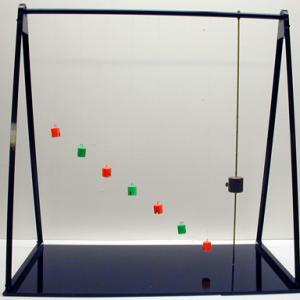College of Liberal Arts & Sciences
3A60.30 - Barton's Pendula
Adjust the large driving pendula to a desired height and set into motion. After a few oscillations one of the pendula should be oscillating in resonance with the driving pendula, but almost 180 degrees out of phase.
- Thomas B. Greenslade Jr., "Sympathetic Resonance: A New Use for an Old Demonstration", TPT, Vol. 50, #6, Sept. 2012, p. 369.
- Timothy J. Moran, Bradford K. Hill, "Apparatus for Teaching Physics - Inexpensive Resonance Analysis", TPT, Vol. 47, # 9, December 2009, p. 599.
- Wojciech Dindorf, "String of Pearls Resonance", TPT, Vol. 39, # 4, Apr. 2001, p. 251.
- Eduardo C. Valadares and Cleber P. A. Anconi, "Dancing to the Music", TPT, Vol. 38, # 7, Oct. 2000, p. 404.
- John D. McGervey, "Hands-On Physics for Less Than a Dollar per Hand", TPT, Vol. 33, # 4, p. 238 - 241, April 1995.
- Terry A. Scott, "Resonance Demonstrator", TPT, Vol. 21, # 6, Sept. 1983, p. 409.
- Shirin Haque-Copilah, "Extremely Simple Demonstration of Forced Oscillation", AJP, Vol. 64, #4, Apr. 1996, p. 507.
- Richard E. Berg, "Pendulum Waves: A Demonstration of Wave Motion Using Pendula", AJP, 59, # 2, Feb. 1991, p. 186.
- Sd-1: Freier and Anderson, A Demonstration Handbook for Physics.
- 13.29: Tik Liem, "How Many Swings Can You Get?", Investigation to Science Inquiry, p. 347.
- Brown, Science for You-112 Illustrated Experiments, p. 95.
- "Coupled Resonant Pendulums", Exploratorium Science Snackbook - Force and Motion, p. 32- 35.
- 3.16: Charles Taylor, The Art and Science of Lecture Demonstration, p. 150-151.
- "Resonator", Science Snackbook, The Exploratorium.
Disclaimer: These demonstrations are provided only for illustrative use by persons affiliated with The University of Iowa and only under the direction of a trained instructor or physicist. The University of Iowa is not responsible for demonstrations performed by those using their own equipment or who choose to use this reference material for their own purpose. The demonstrations included here are within the public domain and can be found in materials contained in libraries, bookstores, and through electronic sources. Performing all or any portion of any of these demonstrations, with or without revisions not depicted here entails inherent risks. These risks include, without limitation, bodily injury (and possibly death), including risks to health that may be temporary or permanent and that may exacerbate a pre-existing medical condition; and property loss or damage. Anyone performing any part of these demonstrations, even with revisions, knowingly and voluntarily assumes all risks associated with them.
